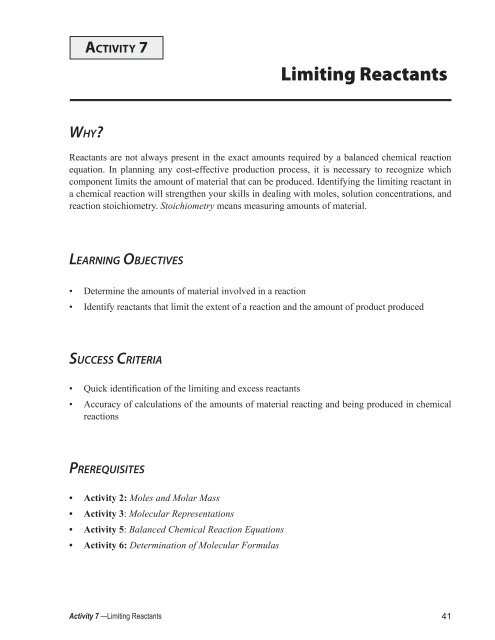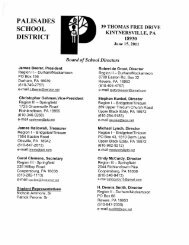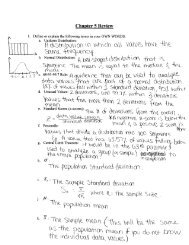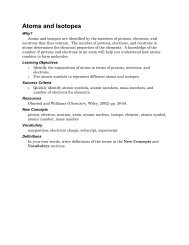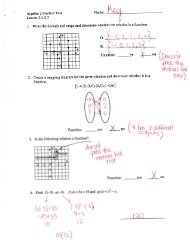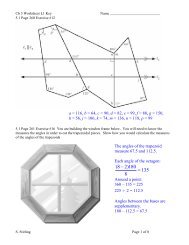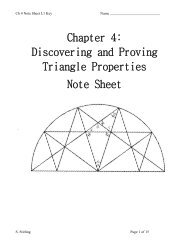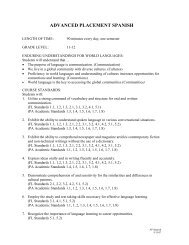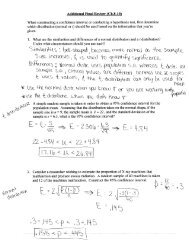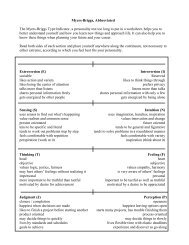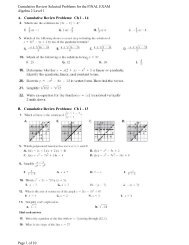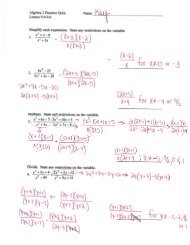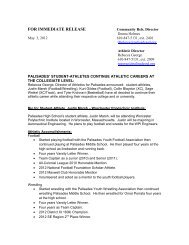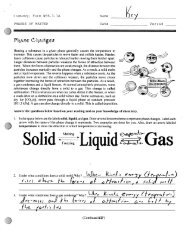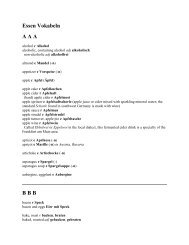You also want an ePaper? Increase the reach of your titles
YUMPU automatically turns print PDFs into web optimized ePapers that Google loves.
Activity 7<br />
<strong>Limiting</strong> <strong>Reactants</strong><br />
Why?<br />
<strong>Reactants</strong> are not always present in the exact amounts required by a balanced chemical reaction<br />
equation. In planning any cost-effective production process, it is necessary to recognize which<br />
component limits the amount of material that can be produced. Identifying the limiting reactant in<br />
a chemical reaction will strengthen your skills in dealing with moles, solution concentrations, and<br />
reaction stoichiometry. Stoichiometry means measuring amounts of material.<br />
Learning Objectives<br />
• Determine the amounts of material involved in a reaction<br />
• Identify reactants that limit the extent of a reaction and the amount of product produced<br />
Success Criteria<br />
• Quick identification of the limiting and excess reactants<br />
• Accuracy of calculations of the amounts of material reacting and being produced in chemical<br />
reactions<br />
Prerequisites<br />
• Activity 2: Moles and Molar Mass<br />
• Activity 3: Molecular Representations<br />
• Activity 5: Balanced Chemical Reaction Equations<br />
• Activity 6: Determination of Molecular Formulas<br />
Activity 7 —<strong>Limiting</strong> <strong>Reactants</strong> 41
Model 1: <strong>Limiting</strong> Ingredient<br />
A cake recipe calls for:<br />
2 cups of water<br />
4 cups of flour<br />
8 squares of chocolate<br />
4 cups of sugar<br />
8 oz of butter<br />
4 eggs<br />
Ingredients on hand:<br />
Figure 7.1<br />
lots of water 5 cups flour 4 cups sugar<br />
12 squares chocolate 16 oz butter 6 eggs<br />
Key Questions<br />
Shaded cells represent completed table entries.<br />
1.<br />
According to Model 1, how much of each ingredient is necessary to make a cake?<br />
water flour chocolate sugar butter eggs<br />
2 cups 4 cups 8 squares 4 cups 8 oz 4 eggs<br />
2.<br />
If you follow the recipe, using only the ingredients on hand in the model, how much of each<br />
ingredient will be left over after you have baked the cake?<br />
water flour chocolate sugar butter eggs<br />
a lot 1 cup 4 squares 0 cups 8 oz 2 eggs<br />
42<br />
Foundations of Chemistry
3. Which of the ingredients on hand were in excess for the recipe?<br />
Water, flour, chocolate, butter, and eggs were in excess.<br />
4. Which of the ingredients on hand were consumed completely in making the cake?<br />
sugar<br />
5. Which of the ingredients limit or prevent you from making a second, smaller cake?<br />
No sugar is left, so a second cake can’t be made, no matter how small.<br />
6. What would be a good definition for the term limiting ingredient?<br />
The limiting ingredient is the component that is completely consumed in producing the<br />
product.<br />
7. What would be a good procedure or methodology to use for identifying the limiting component<br />
in some manufacturing process? Test your methodology by applying it to the following<br />
exercises.<br />
Compare the ratios of the amounts needed to the amounts available. Look for the ratio<br />
that is the smallest. Using the model as an example: The ratio for sugar is 4:4, all the other<br />
ratios are larger than 1:1, e.g., for eggs it is 6:4.<br />
Water: Flour: Chocolate: Sugar: Butter: Eggs<br />
Needed = 2:4:8:4:8:4<br />
Available = ∞:5:12:4:16:6<br />
Exercises<br />
1. You want to make 10 dozen standard-sized cookies as specified by a recipe that requires 16 oz<br />
of butter, 4 eggs, 3 cups of flour, and 4 cups of sugar.<br />
In taking inventory of your supplies, you find that you have 16 oz of butter, 6 eggs, and 3 cups<br />
each of flour and sugar.<br />
a) Express the recipe for these cookies in the form of a reaction equation as started for you<br />
below.<br />
16 oz butter + 4 eggs +<br />
16 oz butter + 4 eggs + 3 cups of flour + 4 cups of sugar 10 dozen cookies<br />
b) Which ingredient will limit the number of cookies you can make?<br />
The sugar will limit the number of cookies you can make.<br />
c) How many standard-sized cookies can you make?<br />
Since you only have 3 cups of sugar, you must cut the recipe by ¾ so you can make<br />
(3/4) × 10 = 7.5 dozen, or 90 cookies<br />
Activity 7 —<strong>Limiting</strong> <strong>Reactants</strong> 43
2. You have 100 bolts, 150 nuts, and 150 washers. You assemble a nut/bolt/washer set using the<br />
following recipe or equation.<br />
2 washers + 1 bolt + 1 nut 1 set<br />
a) How many sets can you assemble from your supply?<br />
You can assemble 75 sets from the supply.<br />
B:N:W have: 100:150:150<br />
need: 1:1:2 or 75:75:150<br />
b) Which is the limiting component?<br />
The washers are the limiting component.<br />
3. This reaction of hydrogen with oxygen to produce water is described by the following recipe or<br />
reaction equation, which says that 2 molecules of hydrogen react with 1 molecule of oxygen to<br />
produce 2 molecules of water.<br />
2H 2 + O 2<br />
2H 2 O<br />
You react 150 H 2 molecules with 100 O 2 molecules to produce H 2 O. Which is the limiting<br />
reactant, hydrogen or oxygen? How many water molecules can you produce from your supply<br />
of hydrogen and oxygen?<br />
The limiting reactant is the H 2 . You can produce 150 water molecules from this supply of<br />
hydrogen and oxygen.<br />
H 2 :O 2 Have 150:100<br />
Need 2:1, or 150:75<br />
Model 2: <strong>Limiting</strong> Reactant in Moles<br />
The reaction equation can be interpreted in terms of the number of molecules (see Exercise 3 above)<br />
or moles reacting (2 moles of hydrogen react with 1 mole of oxygen to produce 2 moles of water).<br />
The only difference is that while a mole can be divided into fractions of a mole, a molecule cannot<br />
be divided. Each square below represents one mole of hydrogen, oxygen, and water.<br />
Figure 7.2<br />
1 mole of H 2 O<br />
1 mole of H 2 1 mole of O 2<br />
1 mole of H 2 1 mole of O 2 ½ mo<br />
When these react according to the reaction equation,<br />
2H 2 + O 2 2H 2 O<br />
44<br />
Foundations of Chemistry
twice as much hydrogen will be used and twice as much water will be produced when compared to<br />
the amount of oxygen that reacts. Figure 7.3 indicates what happens when 1 mole of hydrogen and<br />
1 mole mole of of oxygen H 2 are mixed 1 mole together of Oand 2 react to produce water. It only takes ½ mole of oxygen to<br />
react with the 1 mole of hydrogen, so there is ½ mole of oxygen left over.<br />
Figure 7.3<br />
1 mole of H 2 1 mole of O 2 1 mole of H O 2 ½ mole of O 2<br />
Key Questions<br />
8. How many moles of hydrogen reacted in the above diagram?<br />
one mole<br />
9. How many moles of oxygen remained after the reaction?<br />
½ mole<br />
10. Was hydrogen or oxygen the limiting reactant?<br />
hydrogen<br />
11. In limiting reactant problems, you are sometimes given quantities of reactants in grams. Why<br />
do you need to convert these quantities to moles of reactants in order to solve the problem?<br />
Chemical reactions occur between atoms and molecules. Moles are a way of counting and<br />
keeping track of the numbers of atoms and molecules involved in a reaction. The mass in<br />
grams does not do this because different atoms and molecules have different masses.<br />
Exercises<br />
4. If 6 moles of hydrogen (H 2 ) and 4 moles of oxygen (O 2 ) are mixed and reacted, which is the<br />
limiting reactant? How many moles of water would be produced?<br />
6 moles of hydrogen can produce 6 moles of water.<br />
4 moles of oxygen can produce 8 moles of water.<br />
So hydrogen is the limiting reactant in this case because there is only enough hydrogen to<br />
produce 6 moles of water not 8, with 1 mole of oxygen left over.<br />
5. If you had 1.73 moles of hydrogen (H 2 ) and 0.89 moles of oxygen (O 2 ), which would be the<br />
limiting reactant? How many moles of water can you produce from your supply of hydrogen<br />
and oxygen?<br />
1.73 moles water would be produced with this supply of hydrogen and oxygen. There is<br />
enough oxygen to make 1.78 moles of water, but not enough hydrogen. Hydrogen is the<br />
limiting reactant.<br />
Activity 7 —<strong>Limiting</strong> <strong>Reactants</strong> 45
6. If you had 17.3 g of hydrogen and 8.91 g of oxygen, which is the limiting reactant, and how<br />
many grams of water could you produce?<br />
17.3 g H2<br />
2.02 g/mol<br />
8.91 g O2<br />
32.0 g/mol<br />
=<br />
=<br />
8.56 moles H<br />
2<br />
0.278 moles O<br />
2<br />
The O 2 is the limiting reactant in this case and 0.557 mole water or<br />
0.557 g water × 18 g/mol = 10.0 g water would be produced.<br />
Problems<br />
1. Cisplatin is an antitumor agent. It has the molecular formula Pt(NH 3 ) 2 Cl 2 . How many grams of<br />
cisplatin can be produced if the limiting reactant is 1 kg of platinum?<br />
1000 g Pt<br />
195.08 g/mole =<br />
5.126 mole Pt<br />
1 mole Pt(NH<br />
5.126 mole Pt<br />
3 ) 2Cl<br />
×<br />
2 300.0474 g<br />
×<br />
1 mole Pt 1 mole Pt(NH 3 ) 2Cl2<br />
=<br />
1538 g Pt(NH 3 ) 2Cl 2 produced.<br />
2. Hydrogen cyanide is used in the production of cyanimid fertilizers. It is produced by the<br />
following reaction.<br />
2 CH 4 + 2 NH 3 + 3 O 2 2 HCN + 6 H 2 O<br />
a) How much hydrogen cyanide can be produced starting with 100 kg of each of the<br />
reactants?<br />
100 kg CH 4 = 6233 mol CH 4<br />
100 kg NH 3 = 5872 mol NH 3 ,<br />
100 kg O 2 = 3125 mol O 2<br />
Look at the ratios<br />
6233<br />
methane:<br />
2<br />
= 3117<br />
5872<br />
ammonia:<br />
2<br />
= 2936<br />
3125<br />
oxygen:<br />
3<br />
= 1042<br />
2/3 of 3125 mol can be produced = 2083 mol of hydrogen cyanide, which is 56.3 kg HCN.<br />
b) Which is the limiting reactant?<br />
The smallest ratio is for oxygen, so the limiting reactant is oxygen.<br />
46<br />
Foundations of Chemistry


